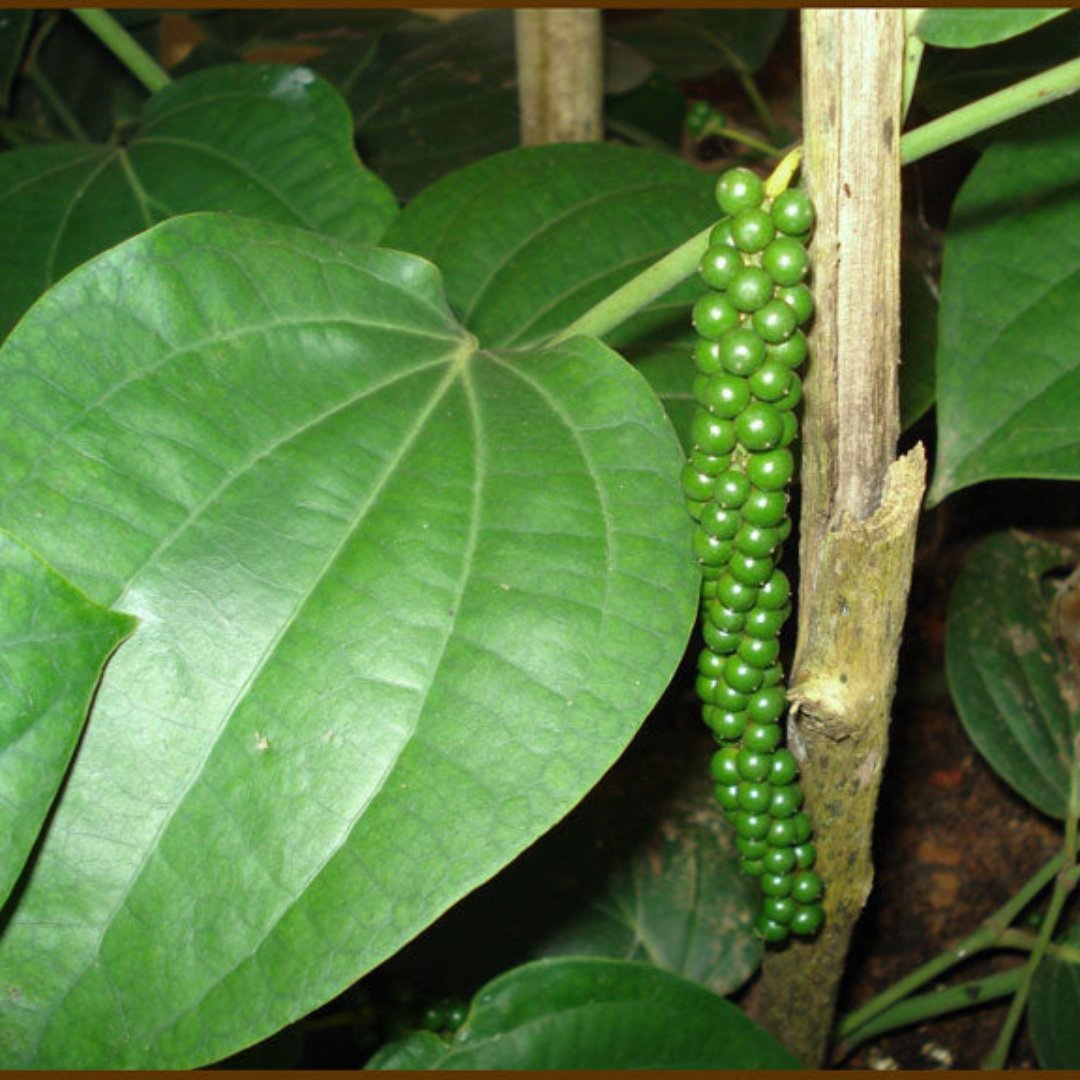


Black pepper Piper nigrum plant
Guaranteed Safe Checkout
Green Paradise Offers Healthy Black
Pepper Piper Nigrum Plant
About Black Pepper Piper Plant
The Black Pepper Plant, scientifically known as Piper nigrum, is a flowering vine in the family Piperaceae. It is native to the Malabar Coast of India and is widely cultivated for its fruit, which is used to produce black pepper, one of the most popular and widely used spices in the world.
Here are some key facts about the Black Pepper Plant:
Appearance:
-
The Black Pepper Plant is a perennial vine that can reach a height of 10 meters or more when grown in its natural habitat.
-
It has heart-shaped, glossy green leaves, and small white flowers that grow in clusters on long spikes.
Fruit:
-
The fruit of the Black Pepper Plant is called a drupe, which is a small, round berry about 5-6 millimeters in diameter.
-
Initially, the berries are green, and they turn red when fully ripe.
-
These berries are harvested at various stages of maturity to produce different types of pepper, such as black, green, white, and red.
Black Pepper Production:
-
Black pepper is produced from the unripe berries of the plant.
-
The berries are harvested and then dried, which causes them to shrivel and turn black.
-
The drying process enhances the flavor and aroma of the berries, resulting in the characteristic spicy and pungent taste of black pepper.
Culinary and Medicinal Uses:
-
Black pepper is an essential spice in many cuisines worldwide.
-
It is used to season a wide variety of dishes, adding heat, depth, and flavor.
-
In addition to its culinary applications, black pepper has therapeutic benefits.
-
It contains a compound called piperine, which has been found to have antioxidant, anti-inflammatory, and digestive benefits.
Cultivation:
-
Black Pepper Plants thrive in tropical climates and require a warm and humid environment to grow successfully.
-
They are usually cultivated in regions with an annual rainfall of 1500-2500 millimeters.
-
The plants prefer well-drained soil and partial shade.
-
The vine needs support to climb, so it is often grown on vertical structures or trellises.
Cultivation Regions:
-
While native to India, Black Pepper Plants are now cultivated in several countries across the globe.
-
Vietnam, Indonesia, Brazil, and Malaysia are major producers.
-
India remains one of the largest producers and exporters of black pepper.
Other Types of Pepper:
-
Apart from black pepper, there are other types of pepper produced from the same plant.
-
Green pepper is made from unripe berries that are freeze-dried or preserved in brine.
-
White pepper is produced from ripe berries that are soaked to remove the outer skin before drying.
-
Red pepper, also known as pink pepper or Brazilian pepper, comes from a different plant species and is not related to black pepper.
Black pepper has a long history of use, dating back thousands of years. It was highly valued in ancient times and was even used as currency. Today, it continues to be a staple spice in kitchens worldwide, prized for its distinctive flavor and versatile applications.
How To Grow Black Pepper Plant
Growing black pepper plants can be a rewarding experience.
Here's a step-by-step guide on how to grow black pepper:
Climate and Soil Requirements:
-
Black pepper plants thrive in tropical climates, with temperatures ranging between 75°F (24°C) and 95°F (35°C).
-
They require high humidity and well-drained, fertile soil.
Obtaining Seeds or Cuttings:
-
You can obtain black pepper seeds or cuttings from a reputable nursery or by purchasing them online.
-
If using cuttings, ensure they are at least 6 inches long and have a few nodes.
Germinating Seeds or Preparing Cuttings:
-
If using seeds, soak them in warm water for 24 hours to enhance germination.
-
Sow the seeds in a seed tray or small pots filled with a well-draining potting mix.
-
Keep the soil moist and warm (around 80°F/27°C) until the seeds germinate, which typically takes 2-3 weeks. For cuttings, plant them directly into pots filled with the potting mix, burying a few nodes beneath the soil.
Planting:
-
Once the seeds have germinated or the cuttings have rooted (typically within 6-8 weeks), transplant them into larger pots or a prepared garden bed.
-
Ensure the location receives partial shade or indirect sunlight.
-
Space the plants around 8-10 feet apart.
Support Structure:
-
As black pepper plants grow, they require support for climbing.
-
Provide a trellis, stakes, or a nearby structure for the vines to climb and attach themselves.
Watering and Fertilizing:
-
Keep the soil consistently moist, but not waterlogged.
-
Water the plants frequently, especially during dry spells.
-
During the growing season, apply a balanced fertiliser every 4-6 weeks to encourage healthy growth.
Pruning:
-
Prune the plants to control their size and promote bushier growth.
-
Regularly trim the vines to encourage lateral branching.
Pests and Diseases:
-
Monitor the plants for pests like aphids, spider mites, and scale insects.
-
Use a horticultural oil or insecticidal soap to eradicate any infestations.
-
Preventive measures include keeping the growing area clean and free from debris.
Harvesting:
-
Black pepper plants typically start producing fruit after 3-4 years.
-
The fruit clusters, called spikes, turn from green to yellowish-red when mature.
-
Harvest the spikes when they are fully ripe but not overripe.
-
Dry them in the sun until they turn dark brown and wrinkled.
Processing:
-
To obtain black pepper, remove the outer skin by rubbing the dried spikes.
-
The inner seed, known as peppercorn, is what you will use as a spice.
Remember that growing black pepper plants can be a long-term commitment due to the time it takes for them to mature and bear fruit. However, with patience and proper care, you can enjoy harvesting your own fresh black peppercorns.
.




